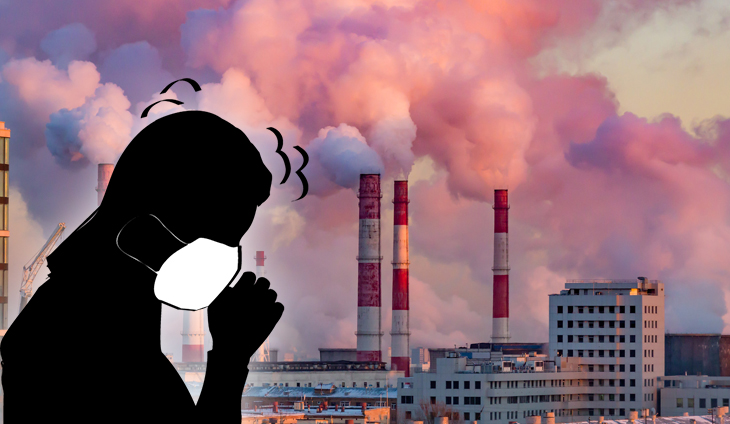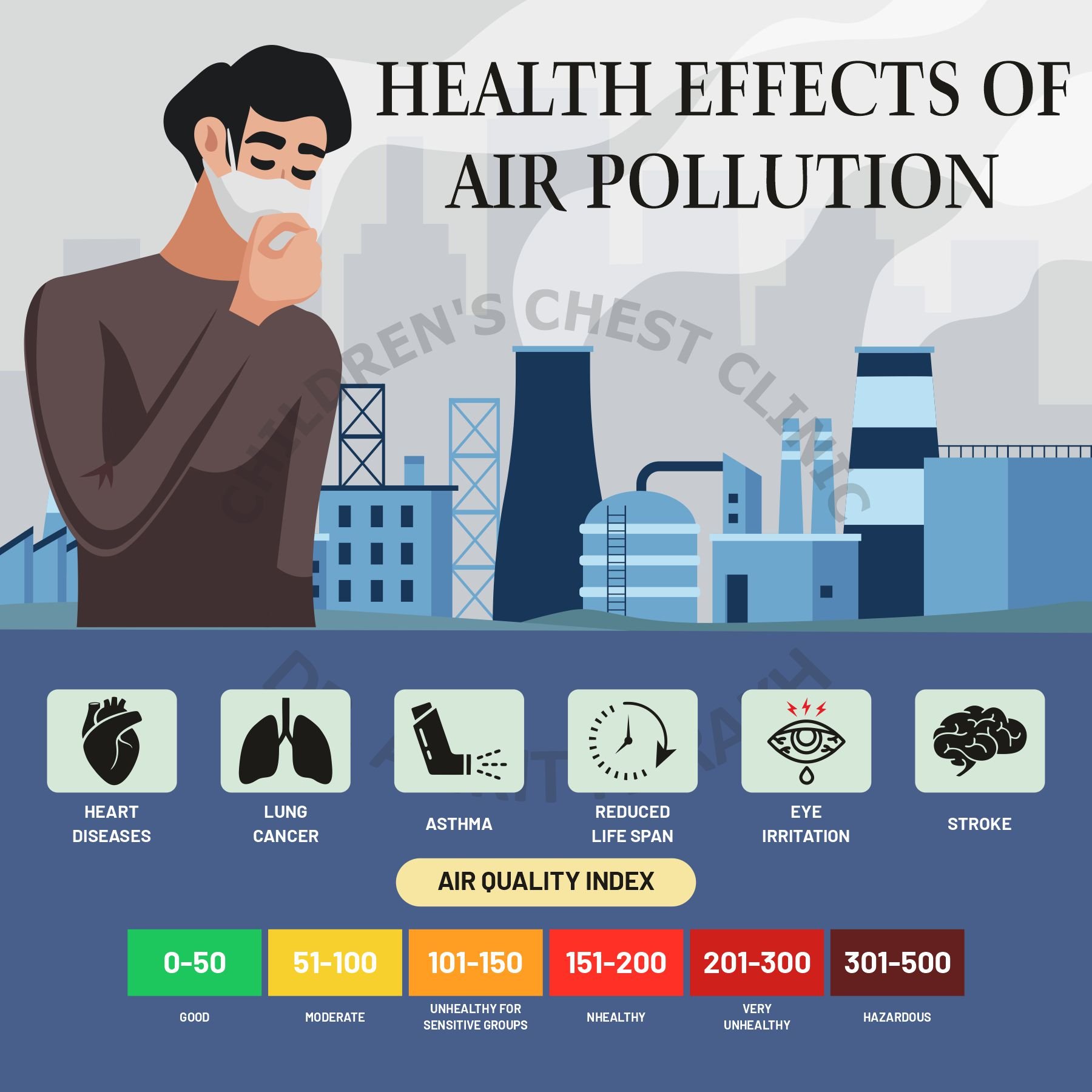The Impact of Air Pollution on Health
Introduction
Air pollution is a pervasive and significant environmental problem that affects millions of individuals across the globe. It is made up of different pollutants such as particulate material (PM), nitrogen oxides (NOx), sulfur dioxide (SO2), carbon monoxide (CO) and volatile organic compounds (VOCs). These pollutants come from multiple sources like industrial operations, vehicle emissions, agricultural practices, and natural occurrences such as wildfires. Air pollution negatively affects health through its adverse effects on respiratory, cardiovascular and neurological systems. Supported by scientific evidence, this paper examines air pollution’s impact on health and highlights the need to address the world-wide issue.
Respiratory Health
Chronic Obstructive Pulmonary Disease
Copd- chronic obstructive pulmonary disease- caused by long exposure to air pollution including asthma; bronchitis [chronic respiratory diseases]. Small particulate matters, especially PM2.5 which are particles less than 2.5 µm penetrate deeply into lungs causing lung inflammation thus making pre-existing lung conditions worse. Researches suggest that higher levels of PM2.5 lead to more hospital admissions due to respiratory diseases thus increases in mortality rates.
Acute Respiratory Infections
Children and old people are highly vulnerable to air pollution that also leads to illnesses like pneumonia and bronchitis which are acute respiratory infections. NOx and SO2, for example, are pollutants that make the respiratory tract an ideal state for infections. Youngsters who live in heavily polluted environments can easily get respiratory problems due to their weak immune system.
Impaired Lung Development
Because they have not yet fully developed, the lungs of children are more affected by air pollution than those of adults. This kind of contamination at high levels may interfere with lung growth and maturation, resulting in reduced lung function extending into adulthood. Some studies have shown that children living in areas with high levels of air pollution possess a lower lung capacity compared to those from cleaner places.
Cardiovascular Health
Heart Disease
Air pollution is one of the major causes of heart attacks, strokes as well as high blood pressure which is otherwise known as hypertension; this makes it a leading risk factor for most cardiovascular diseases. For instance, PM2.5 and NOx brought about by air pollution can lead to systemic inflammation and oxidative stress when entering into the bloodstream.Otherwise stated these processes eventually contribute towards atherosclerosis such as hardened arteries found on fats deposits thereby causing stoke or heart attack.
Hypertension and Arrhythmias
It is shown that high blood pressure, or hypertension and arrhythmias (abnormal heart rhythm) may be caused by exposure to air pollution. The risk of cardiac diseases and strokes may be increased due to long-term effects of contaminated air leading to chronic hypertensions. Furthermore, studies have indicated that intense presence of air pollution for a short period of time can cause sudden cardiac events.
Increased Mortality
According to the World Health Organization (WHO), it is believed that around 7 million premature deaths occur annually as a result of air pollution with significant cardiovascular disease among them. It is clear that this link between air pollution, mortality rates increase shows how polluted air can take a serious toll on cardiovascular health.
Neurological Health
Cognitive Decline and Dementia
Recently published studies seem to suggest that contamination leads to cognitive decline and neurodegenerative diseases like Alzheimer’s disease and Parkinson’s disease. Blood-brain barrier can be crossed by pollutants such as PM2.5 which results in brain inflammation and damage of its cells. Reduced intellectual capacity as well as higher chances for elderly people developing dementia are some long-term consequences resulting from living in environments with polluted air.
Impact on the Cognitive Development of Children
Dull intellectual development, which affects studies and performance at school, may be a side effect for children who are exposed to high levels of air pollution. Comparatively, polluted areas have been associated with poor cognitive performance in children as compared to cleaner regions. In addition, such pollutants have neurotoxic effects that interfere with development of brain tissues hence resulting into sustainable impairment.
Mental health disorders
There is now increasing evidence that air pollution can contribute to mental health problems like depression and anxiety. Pollutants can cause systemic inflammation and oxidative stress which are linked to the pathogenesis of mental illnesses. On the other hand, people living in highly polluted regions showed higher incidences of depressive and anxious conditions than their counterparts who enjoyed cleaner air.
Vulnerable populations
Children and Infants
The exposure to toxins can cause far-reaching respiratory, cardiovascular, neurological effects among others in children and infants due to their growing body organs systems and immune system.Kids are essentially more likely to develop these diseases once they are exposed to pollutants while still at a tender age as compared to adults.This therefore means that bad air could result into retarded growth or even preterm birth if these kids get exposed while still in their mother’s womb.
Elderly
As people age, their bodies’ natural ability to withstand pollution decreases and they also have more chronic diseases. It should be noted that air pollution can worsen existing health problems, which often lead to heart attacks and increased likelihood of respiratory difficulties resulting in high incidence rates of poor health status among older persons.
Individuals with Pre-existing Conditions
People with preexisting respiratory and heart diseases are particularly vulnerable to the harmful effects of air pollutants. Even as little as a short-term exposure to toxic gases can result into hospitalization of such patients due to serious illnesses and a rise in mortality rates.
Socioeconomic Impact
Healthcare Costs
The medical consequences of indoor pollution have substantial economic implications such as increased costs for hospitalization charges and lifetime care required for people who become chronically ill. In areas where there is much polluted air, the burden on healthcare systems is huge.
Loss of Productivity
Air pollution is responsible for reduced productivity due to frequent absence from work because of illness or diminished work capacity caused by sickness. Illnesses resulting from the polluted environment will bring about cases where the affected individuals may be unable to participate in any income generating activity due to chronic conditions or mental problems that originate from deteriorated environmental conditions caused by toxins in the air.
Environmental Justice
Poor and marginalized communities are disproportionately affected by air pollution which worsens health inequality. These areas often house these communities because of higher levels of pollution resulting from industrial operations, traffic emissions, and inadequate infrastructure. Tackling air pollution is crucial for promoting environmental justice and ensuring equitability in health outcomes across populations.
Conclusion
Air pollution has a huge impact on health through its multifaceted effect on the respiratory system, cardiovascular system and nervous system. Among those most likely to experience poor health outcomes as a result of this include children, old people and individuals with pre-existing conditions. This is also reflects in the financial implications of polluted air like increased expenses in healthcare provision as well as reduced production that emphasizes on urgency associated with addressing this global issue.
Collective efforts should be focused towards curbing this sort of pollution including tougher emission control measures, supporting renewable energy sources as well as facilitating public awareness campaigns. Other than this, individuals themselves play their roles to manage their environment well by using public transport means , reducing power consumption and backing policies aimed at making the atmosphere cleaner. By working together for a common cause we can lessen the burden of diseases that are caused or exacerbated by air pollution.



























